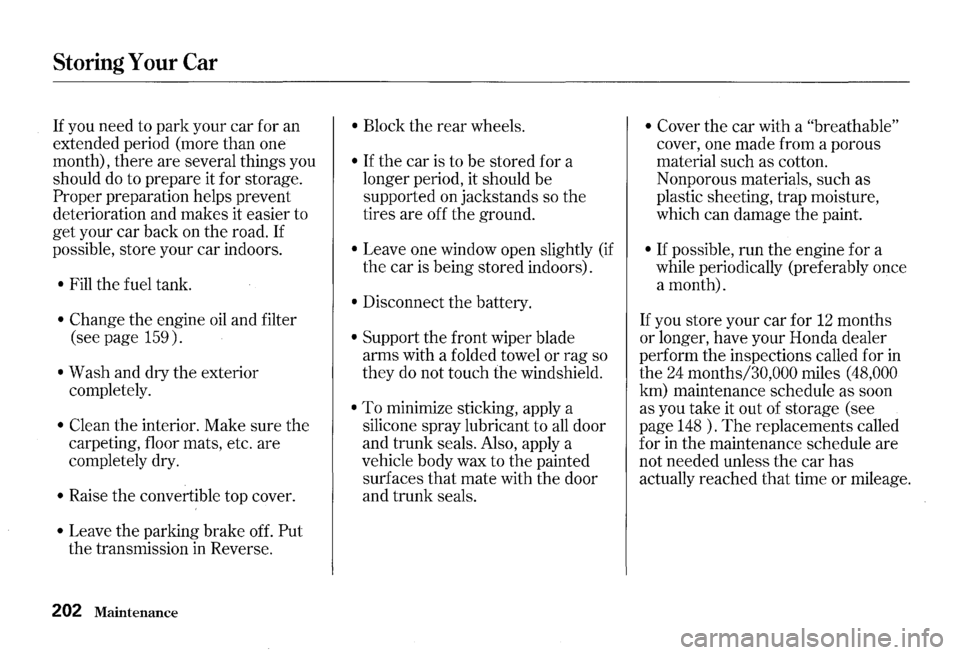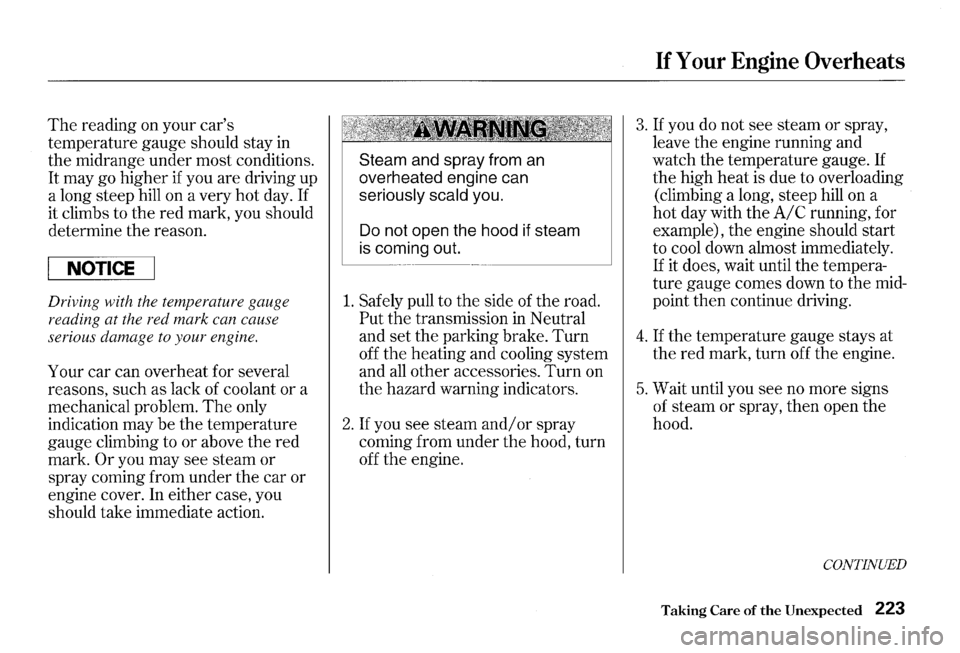2000 HONDA S2000 parking brake
[x] Cancel search: parking brakePage 158 of 273

You should check the following
items at the specified intervals.
If
you are unsure of how to perform
any check, turn to the page given.
• Engine oil level -Check every
time you
fill the fuel tank. See
page 119.
• Engine coolant level -Check the
radiator reserve tank every time
you
fill the fuel tank. See page 120 .
• Windshield washer fluid -Check
the level in the reservoir monthly.
If weather conditions cause you to
use the washers frequently, check
the reservoir each time you stop
forfuel. See page 167.
• Brakes and clutch -Check the
fluid level monthly. See page
170 .
Owner Maintenance Checks
• Tires -Check the tire pressure
monthly. Examine the tread for
wear and foreign objects. See page
186.
• Lights -Check the operation of
the headlights, parking lights,
taillights, high-mount brake light,
turn signals, brake lights, and
license plate lights monthly. See
page 192.
Maintenance 155
Page 196 of 273

Lights
Check the following:
• Headlights (low and high beam)
• Parking lights
• Taillights
• Brake lights
• Turn signals
• Back-up lights
• Hazard light function
• License plate light
• Side marker lights
• Daytime running lights
(Canadian cars)
If you find any bulbs are burned out,
replace
them as soon as possible.
Refer to the chart on page
245 to
determine what type of replacement
bulb is needed.
Maintenance 193
Page 205 of 273

Storing Your Car
If you need to park your car for an
extended period (more than one
month), there are several things you
should
do to prepare it for storage.
Proper preparation helps prevent
deterioration and makes it easier to
get your car back on the road.
If
possible, store your car indoors.
• Fill the fuel tank.
• Change the engine oil and filter
(see page 159).
• Wash and dry the exterior
completely.
• Clean the interior. Make sure the
carpeting, floor mats, etc. are
completely dry.
• Raise the convertible top cover.
• Leave the parking brake off. Put
the transmission in Reverse.
202 Maintenance
• Block the rear wheels.
• If the car is to be stored for a
longer period, it should be
supported on jackstands so the
tires are off the ground.
• Leave one window open slightly (if
the car is being stored indoors).
• Disconnect the battery.
• Support the front wiper blade
arms with a folded towel or rag so
they
do not touch the windshield.
• To minimize sticking, apply a
silicone spray lubricant to
all door
and trunk seals. Also, apply a
vehicle body wax to the painted
surfaces that mate with the door
and trunk seals.
• Cover the car with a "breathable"
cover, one made from a porous
material such as cotton.
Nonporous materials, such as
plastic sheeting, trap moisture,
which can damage
the paint.
• If possible, run the engine for a
while periodically (preferably once
a month).
If you store your car for 12 months
or longer, have your Honda dealer
perform the inspections called for
in
the 24 months/30,000 miles (48,000
km) maintenance schedule as soon
as you take it out of storage (see
page
148 ). The replacements called
for
in the maintenance schedule are
not needed unless the car has
actually reached that time or mileage.
Page 216 of 273

If you have a flat tire while driving,
stop in a safe place to change it.
Stopping in traffic
or on the shoulder
of a busy road is dangerous. Drive
slowly along
the shoulder until you
get to an exit or an area to stop that
is far away from the traffic lanes.
The car can easily roll off the
jack,
seriously injuring anyone
underneath.
Follow the directions for
changing a tire
exactly, and
never get under the car when it
is supported only by the jack.
The compact spare tire is smaller
than a standard tire, which
will affect
the vehicle's handling. Drive
cautiously when this spare is
mounted on your vehicle.
The size difference may also cause
damage to
the rear differential, so do
not mount
the compact spare on the
rear. If either rear tire goes flat,
remove
the front tire on that same
side, mount
the compact spare tire
on
the front, then mount the front
tire on
the rear.
1. Park the car on firm, level, non
slippery ground away from traffic.
Put the transmission in Reverse.
Apply
the parking brake.
2. Turn on the hazard warning lights
and turn
the ignition switch to
LOCK (O). Have your passenger
get out of the car while you
change
the tire.
Changing a Flat Tire
3. Open the trunk. Lift up the tool
box lid and take
the jack, wheel
wrench and extension out of
the
tool box.
NOTICE
Use the jack that came on your car. If
you try to raise another car by this jack
or use another jack to raise your car,
the car
or jack can be damaged.
CONTINUED
Taking Care of the Unexpected 213
Page 223 of 273

Jump Starting
If your car's battery has run down,
you may
be able to start the engine
by using a booster battery. Although
this
seems like a simple procedure,
you should take several precautions.
220 Taking Care of the Unexpected
A battery can explode if you do
not
follow the correct procedure,
seriously injuring anyone
nearby.
Keep
all sparks, open flames,
and smoking materials away
from the battery.
To jump start your car, follow these
directions closely:
1. Open the hood and check the
physical condition of the battery
(see page 177 ) . In very cold
weather,
check the condition of
the electrolyte. If it seems slushy
or like ice, do not
try jump starting
until it thaws.
NOTICE
if a battery sits in extreme cold, the
electrolyte inside can freeze.
Attempting
to jump start with a frozen
battery can cause it
to rupture.
2. Turn off all the electrical acces
sories: heater,
A/C, stereo system,
lights, etc.
Put the transmission in Neutral
and
set the parking brake.
Page 226 of 273

The reading on your car's
temperature gauge should stay in
the midrange under most conditions.
It may go higher if you are driving up
a long steep hill on a very
hot day. If
it climbs to the red mark, you should
determine
the reason.
NOTICE
Driving with the temperature gauge
reading
at the red mark can cause
serious damage to your engine.
Your car can overheat for several
reasons,
such as lack of coolant or a
mechanical problem.
The only
indication may be
the temperature
gauge climbing to or above
the red
mark. Or you may see steam or
spray coming from
under the car or
engine cover. In either case, you
should take immediate action.
Steam and spray from an
overheated engine can
seriously scald you.
Do not open the hood if steam
is coming out.
1. Safely pull to the side of the road.
Put the transmission in Neutral
and
set the parking brake. Turn
off the heating and cooling system
and all
other accessories. Turn on
the hazard warning indicators.
2. If you see steam and/ or spray
coming from
under the hood, turn
off
the engine.
If Your Engine Overheats
3. If you do not see steam or spray,
leave
the engine running and
watch
the temperature gauge. If
the high heat is due to overloading
(climbing a long, steep hill on a
hot day with
the A/C running, for
example),
the engine should start
to cool down almost immediately.
If it does, wait until the tempera
ture gauge comes down to
the mid
point
then continue driving.
4. If the temperature gauge stays at
the red mark, turn off the engine.
5. Wait until you see no more signs
of
steam or spray, then open the
hood.
CONTINUED
Taking Care of the Unexpected 223
Page 232 of 273

The Brake System Indicator light
comes on when you turn the ignition
ON (II). If the parking brake is not
set, it goes off after you start the
engine.
If the parking brake is set, it
goes off when you fully release the
parking brake with the engine
running. If
it comes on at any other time, it
indicates a problem with
the car's
brake system. In most cases, the
problem is a low fluid level in
the
brake fluid reservoir. Press lightly on
the brake pedal to see if it feels
normal.
If it does, check the brake
fluid level the next time you stop at a
service station (see page
170 ) . If the
fluid level is
low, take the car to your
dealer and have the brake system
inspected for leaks or worn brake
pads.
However,
if the brake pedal does not
feel normal, you should take
immediate action. Because
of the
brake system's dual-circuit design, a
problem
in one part of the system
will still give you braking at two
wheels.
You will feel the brake pedal
go down much farther before the car
begins to slow down, and you
will
have to press harder on the pedal.
The distance needed to stop will be
much longer.
Brake System Indicator
Slow down by shifting to a lower
gear, and pull to the side of the road
when it is safe. Because
of the
longer distance needed to stop, it is
hazardous to drive the car.
You
should have it towed, and repaired as
soon as possible.
If you must drive the car a short
distance in this condition, drive
slowly and cautiously.
Taking Care of the Unexpected 229
Page 264 of 273

A
Accessories Installation .................................. 122
Accessory
Power Socket ................ 81
ACCESSORY (Ignition Key
Position) ........................................
61
Adding
Brake Fluid ................................. 170
Clutch Fluid ................................ 171
Engine Coolant.. ......................... 161
Engine
Oil ................................... 157
Manual Transmission Fluid ..... 168
Windshield
Washer Fluid ......... 167
Additional Information About
Your
Seat Belts ........................ 33
Lap/Shoulder Belt.. ..................... 33
Seat Belt Maintenance ................ 34
Seat Belt System Components
... 33
Additional Information About
Your SRS ...................................
37
Additional Safety Precautions .... 38
How
the Automatic Seat Belt
Tensioners Work ..................... 37
How Your Airbags Work ............ 35
How the SRS Indicator
Works ........................................ 37
SRS Components ......................... 35
Additives, Engine Oil... .................. 158
Adjustments
Mirrors ..........................................
79
Seats .............................................. 68
Airbag (SRS) ...................................... 9
Air Cleaner Element.. ....................
l72
Air Conditioning ............................... 86
Maintenance ............................... 182
Usage ............................................. 86
Air Outlets (Vents) .......................... 88
Air Pressure,
Tires ........................ 185
Alarm, Anti-theft.. .......................... 113
Alcohol in Gasoline ........................ 248
Aluminum Wheels, Cleaning ........
206-
Antifreeze ....................................... 161
Anti-lock
Brakes (ABS)
Indicator Light ..................... 45, 138
Operation .................................... 136
Anti-theft Steering Column Lock
.. 60
Anti-theft System ........................... 113
Appearance Care ...........................
203
Audio Panel. ...................................... 82
Audio System ................................... 94
Index
Automatic Car Washes ................. 204
Automatic Speed Control.. .............. 55
IB
Back-up Lamp Replacement.. ....... 198
Battery Charging System
Indicator.. .......................... 44, 227
Jump Starting ............................. 220
Maintenance ............................... 177
Specifications ............................. 245
Before Driving ............................... 115
Belts, Seat ........................................... 8
Beverage Holder ..............................
81
Body Repair .................................... 210
Brakes ............................................. 136
Anti-lock System (ABS) ............ 137
Break-in, New Linings .............. 116
Fluid ............................................
170
Light, Burned-out ...................... 198
Parking .......................................... 80
System Indicator .......................... 44
Wear Indicators, Disc ............... 136
CONTINUED